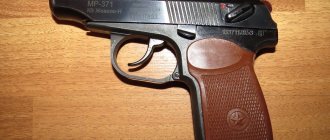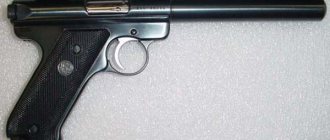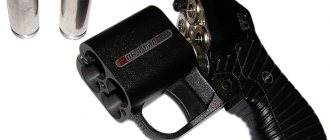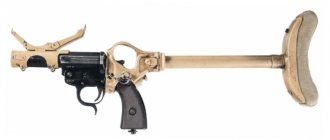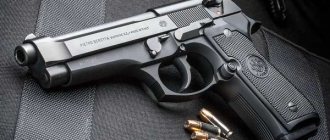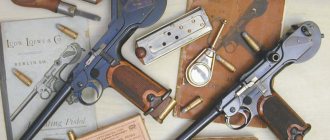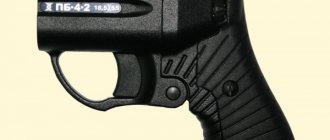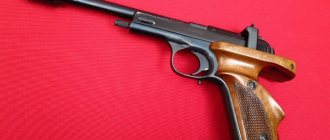Throughout the existence of human civilization, weapons as such have periodically undergone many different changes. Since firearms were invented, people have constantly tried to improve them, making them more effective and easier to use. However, sometimes the result of some of the work of design engineers was very original things.
This material will present to your attention a list of firearms that are striking both in their appearance and in their unique capabilities. Some of them made a real revolution in the military field. While others were more of a luxury item and did not represent any practical value at all.
Introducing the top 10 most incredible firearm modifications.
German six-barreled ax
In the eighteenth century, the ax was rightfully considered a privileged weapon. Depending on the financial capabilities of the owner, it is equipped with a variety of additional functions.
A dagger could be hidden in the handle; the hollow shaft could be a convenient container for swords, which were not secured by anything, so they could jump out with a slight push.
However, the pinnacle of various technical variations of the ax is considered to be the synthesis of an ax with a pistol. For this weapon, the barrel was located at the end of the handle, near the blade, which, in turn, served as the barrel.
Such axes were very popular among people of the noble class who lived in the second half of the 16th century, but closer to the 17th century no one used the ax as a fighting ax.
Beretta Auto 9 "RoboCop" (1987)
Already in the very first film about a robot policeman by Paul Verhoeven, RoboCop is armed with a futuristic Auto 9 pistol. This is a highly modified Beretta 93R pistol, equipped with an elongated barrel with a raised front sight and an enlarged rear sight. Even though Auto 9 was created specifically for the 1987 film, it became so popular that it has since been used in all the RoboCop TV and film sequels. After the release of the film, many recruits to police academies in the United States who were not cyborgs passionately dreamed of getting a “gun like RoboCop” as a service weapon.
According to actor Peter Weller, who played the main role in the action film, Auto 9 was perfectly balanced and it was possible to quickly get used to it for high-quality training of all scenes with weapons in the film. The only difficulty was with RoboCop's signature move, where he twirls the gun on his finger before putting it back in the holster - an element that required a lot of training.
Curved weapon
The idea of a curved-barrel weapon was not given to many military designers for many years. Pistols and rifles designed for shooting from cover were developed back in the century before last.
However, this idea began to be actively implemented only in the 20th century. Germany is considered to be the first state in whose territory such research was actively conducted. During the First World War, Finnish scientists invented a device with a periscope for the Mosin rifle.
BlasTech E-11 Blaster "Star Wars" (1977)
Imperial stormtroopers use a wide variety of weapons throughout the Star Wars saga, but the most memorable is the BlasTech E-11 Blaster. It is this example of imperial design thought that is best known to every viewer of the immortal creation of George Lucas.
The E-11 Blaster is based on the British Sterling Arms Mk4 (L2A3), a British submachine gun chambered for the 9x19mm Parabellum pistol cartridge. In turn, the L2A3 became an evolution of the famous Sten, which became the “calling card” of the British army during the Second World War.
To add a futuristic feel to the 1950s-era weapon, props workers glued rubber bands from the windshield wipers to the vents on the forend, cut off a 30-round magazine, and installed a “vintage” M38 tank alt-azimuth sight from 1942 on the weapon. The tank sight was nice, but, unfortunately, it did nothing to help stormtroopers accurately hit the Jedi and rebels.
King Henry VIII's Staff
The infamous King of England Henry VIII went down in history as a “black widower” and a lover of unusual weapons. His collection contained the most unusual examples of military weapons of that time.
A special place in his collection is occupied by a cane with a morning star on the handle, in which three pistols with a wick fuse were located. Now this extraordinary product can be seen in the Tower of London.
arbalet-airgun
Today we will radically change the classical chronology of constructing articles - we will start with the realities of today and slowly delve into the darkness of centuries.
Combat pneumatics of our days
So, is the existence of pneumatic small arms realistic in the age of machine guns and tanks? All open and not so open sources indicate that combat pneumatics to some extent repeat the fate of arrow throwers (see “Combat crossbows”) and are used exclusively for special operations. Moreover, it clearly cannot be classified as army weapons; these devices are in demand by the knights of cloak and dagger.
As in the case of crossbows (read about “Big” and “Little Joe” in the historical section of the article mentioned above), the beginning was made during the Second World War by the predecessor of the CIA, the Office of Strategic Services. Flying Dragon SAC-46 ” (pictured) was born in 1943
Little is known about it, simply because only 12 units of the Flying Dragons were produced and only one of them participated in an actual operation. Again, the only one. Although, according to some data, the sighting range of the “acid gun” (a 12-gram canister of CO2 was used) was considerable 37 meters, and the active substance applied to the tip (poison, sleeping pills?) was quite functional, the recharging process was quite long and time-consuming to repeat there was virtually no shot left. Plus - or rather, minus - the rather loud bang of the shot.
In general, as in the case of “Joe,” the theme was not developed then. What now? If information about the crossbows used in the special services and armies of different countries is still leaking out, then there is a conspiracy of silence around pneumatics :)). True, she often appears in “spy novels” and action films. Moreover, there is a suspicion that in reality they are not using some developments of secret centers, but quite “consumer consumer goods” products.
We invite you to familiarize yourself with the article “Weapons for remote immobilization” published on our website. In particular, it describes commercial pneumatic devices for animal immobilization. Now compare the “Flying Dragon SAC-46” with the “Dan-Inject Model JM Special” presented in it (pictured) - in fact, the difference is only in the exterior of the old combat and modern commercial models.
Or watch the episode from the legendary “Commando”, where the renegade Bennett uses an air pistol to neutralize Arnold Schwarzenegger’s invincible hero, Colonel John Matrix.
And how is the device he used radically different from the one discussed in the article about the remote immobilization weapon of the LEADER-4pgl kit? Unless the latter is also multi-charged.
You can throw not only darts with an active substance - compressed air is capable of more (see “Pneumatic crossbow and other unusual arrow throwers”).
By the way, in “spy” literature, air pistols and rifles are often used, say, to remotely destroy light sources that interfere with an operation, destroy security cameras, and even to deliver tiny microphones to an object of interest. Well, let’s believe the authors... Cinema could not do without such devices. Walther
LP 53
spring-piston pistol in the hands of the protagonist of one of the best Bond films.
Many, many years later, this legendary weapon was replaced by a much more advanced descendant (see “The Newest Olympic Class Air Pistol “Walther LP500”).
Oddly enough, it was not possible to find any information about the use by people in uniform of the recently actively developing heavy-duty pneumatic weapon of the “BigBore” class (in the photo - a 12.7 mm “Umarex Hammer”).
Maybe because even these monsters with a muzzle energy of a thousand (!) joules cannot withstand competition with classic firearms (see “Large-caliber pneumatics: what can we expect in Russia?”), not to mention the models developed specifically for the needs of special services (“Large-caliber small arms, or “We need a bigger gun...”).
Or maybe they are simply trying not to advertise such options for their use. In general, it seems that “combat” pneumatics are still in service, except that, unlike crossbows, they prefer to hide in the shadows. Attention: if handled carelessly, even a 4.5 mm air rifle can pose a threat to the life and health of others (for details, see the article “Bow, crossbow, pneumatics: fakes, injuries, crime...”).
Be careful. PS By the way, in our opinion, priority in the use of air weapons in war in modern times should still be given to the unknown Austrian master who created the “Partisan PCP rifle” in 1940. That's what we'll talk about now.
"Partisan PCP rifle" in the fight against the Nazis
There is very little information about this unique example of a truly military pneumatic weapon. It is known that it was created in 1940 or a little later by a certain Austrian partisan, a former cyclist. The choice of the pre-pumped pneumatic principle (PCP) is therefore not surprising.
Almost everyone knows about the powerful Austrian Nazi “fifth column”, which enthusiastically and actively contributed to the Anschluss, but for some reason much less is said about the existence of the Resistance movement. At first, back in the late 30s, it was mainly engaged in sabotage, but then it switched to armed struggle. Partisan groups and detachments were formed.
Well, okay, anyone who is interested will find where to read about it in detail. Let's return to the actual hero of our story. The rifle of an unusual caliber 11.76 mm (.463) fired lead bullets, but its actual performance characteristics are unknown, and one can only guess about effective fire distances and lethality. It seems that it was used to remove sentries, as well as eliminate representatives of the command staff and drivers of vehicles. There is information, although rather vague, that it was used to hit targets even at 100 yards.
Pneumatic combat knife
We are not talking about the so-called “shooting knives”, like the good old family of NRS (Special Scout Knife) or the new 2022 “Arsenal RS-1” (see the article “Multi-charge shooting knives”), only where compressed gases are used instead of powder gases air. Owners of gas-cylinder acid pistols, be proud of your devices! A joke... Although not quite a joke: carbon dioxide canisters are used in really serious samples. For example, in a powerful hunting arrow thrower “Airrow Stealth Model 8S1P” or in a weapon for remote immobilization.
WASP Injector Knife presented to you today, liquefied gas is by no means used to, say, throw a blade at an enemy. He himself is a damaging element. Upon impact and penetration into the body, instantly expanding CO2 from the cylinder through the channel enters the hole in the upper part of the blade and literally bursts into the flesh. In this case, massive tissue rupture occurs, and under water this effect will even intensify. In addition, the freezing effect is also added.
The manufacturers themselves address it:
- divers, snorkelers, surfers - for example, against sharks;
- hunters - for example, against bears;
- for pilots flying over water or over forests - in case of an emergency landing, again against the unfortunate :)) sharks and bears;
- security (military and police) special forces - “for special operations”*.
*The latter raises some doubts, since a person is not a shark or a bear; in principle, an ordinary knife is quite enough for him. Especially in trained hands.
However, it was not by chance that the developers gave this name to their brainchild. Well, “Injector” and “Knife” do not need translation, but “WASP” is nothing more than the former (back in the 60s) name of a special assault unit, now widely known as SWAT. That is, the secret marketing message probably sounded like this: “Buy, you bastards, quickly buy our knives for your special forces!”
New era pneumatics in war and hunting
Oddly enough, the impetus for the emergence of pneumatic rifles came from the emergence and increasingly widespread use of firearms. Even the great Leonardo and Benvenuto Cellini seem to have had a hand in their development, but no objective information about this has reached us. But later devices are evidenced not only by descriptions (sometimes with detailed drawings), but also by very real working samples stored in museums. Like the two guns stored in the Stockholm Museum, equipped with a manual pressure pump, made in the 17th century for Queen Christina Augusta by master Hans Köhler.
There were also very unusual examples, for example, this one - with a balloon made in the form of a sphere, created by the Dutch master Andreas Dolep in 1695.
The absolute majority of these weapons were used for hunting purposes and tasks, including using arrows rather than bullets, as described in our article “Pneumatic crossbow and other unusual arrow throwers.” Although there is information about the conspirators acquiring a powerful air rifle for a classic contract political assassination - the attempt on Cromwell in 1655, which did not take place for various reasons.
However, in the general series there is one striking exception - the famous Girardoni rifle . It was at the end of the 18th century that it was actually adopted for service in Austria. Moreover, during the wars with France, it managed to prove itself so much that Napoleon ordered that shooters captured with this pneumatic weapon in their hands be shot on the spot. A lot has been written about this legendary specimen and very professionally; the information is widely available on the Internet, so I will not go into the essence of the issue. I will dwell on just one point.
Pay attention to the photo. Here the Girardoni rifle is presented complete with a spare cylinder. It is not difficult to guess that it also acts as a butt. A very original solution! The most interesting thing is that, for example, the overseas Condor was made according to the same scheme:
Until recently, this arrangement was a kind of calling card of this arms company, but now many leading manufacturers demonstrate a similar approach.
It is impossible not to note that until now we have talked about air rifles/shotguns with pre-pumping - peculiar prototypes of the current PCP pneumatics. However, the Vienna Historical Museum houses a truly unique example - probably the world’s first spring-piston air rifle (photo taken from the wonderful article “History of Combat Pneumatics”).
Since we are talking about the 1590s, the answer to the question “what came first - PeTsePe or “springs”? — does not seem so clear-cut.
Although... Now we will turn to pre-inflated pneumatics, firstly, clearly older than all the samples discussed above, and secondly, in comparison with them, much more lethal. So,
The deadliest pneumatic weapon
If the conversation turns to the history of air guns, then the first thing that comes to mind is the Girardoni PCP rifle, created in 1780, and much less often - the spring-piston device of 1590, now kept in the Vienna Museum. Among the exotic, of course, are blow pipes, best known as sarbakans, but under different names they are still used not only by various kinds of aborigines, but also in the immobilization of animals. But there were also truly combat models of pneumatic weapons of unprecedented effectiveness. We’ll talk about them now, again moving along the reverse timeline.
Pneumatic artillery
It owes its appearance to the emergence of powerful explosives for filling projectiles, primarily to the famous invention of A. Nobel. The term “dynamite guns” even became attached to such weapons. But the thing is that although the same dynamite was much more “phlegmatic” than its base - nitroglycerin, it clearly did not reach the durability of later compositions, and such a filling could well detonate in the barrel bore immediately at the moment of the shot. Is it necessary!? Moreover, the propellant charge itself, based on the gunpowders of that time, was extremely sensitive to storage conditions, which was especially noticeable in the navy.
A kind of solution (at least temporary) was found in the second half of the 19th century in the form of pneumatic artillery guns, much more “calm” than their firearm counterparts. The most famous are the three 15-inch guns installed on the experimental American ship USS Vesuvius. They were developed by artillery officer Edmund Louis Gray Zalinski, who even founded his own armory. Interestingly, Zalinski was soon replaced as chief designer by a former artillery officer of the Russian army named Rapieff (that is, Repyev, according to the Topwar portal).
In the photo - the “Rapieff-Zalinski” version, intended for coastal defense
The compressor, designed for a pressure of 140 atm, was driven by a steam engine, but the actual operating pressure was about 70 atm (by the way, the situation is approximately the same with modern PCP air rifles). And, despite the not too great range and accuracy, the power of the charge, unattainable for the then gunpowder artillery, was extremely destructive even against battleships. It is not surprising that similar developments were carried out in a number of other countries, in particular Italy and Germany.
But time passed, and the advent of smokeless powders with uniform and completely controlled combustion, as well as new, more load-resistant explosives, gave a new impetus to the development of classical artillery. And the “dynamite guns” retired at the beginning of the 20th century. True, there is information about the use of pneumatic mortars during the First World War, but they also lost out to their then actively developing counterparts of the modern type. Nowadays, it is combat pneumatic artillery that is absent as a class, but similar models are used, for example, as anti-avalanche weapons.
"Greek Fire" - a medieval wunderwaffe
Now let's get acquainted with the device, the probable appearance of the prototype of which is generally dated back almost two thousand years ago, and the real one - to 673 AD. The “Greek fire” created then by Kalinnik helped the Byzantine emperor Constantine IV to defeat the Arab fleet in 678, with a repeat in 717-718.
The picture shows, in our opinion, a rather fantastic version of a throwing device, which anticipated modern flamethrowers and is essentially akin to current air rifles with pre-pumping. And isn’t the pump here from HILL :))? Most likely, in real life, devices similar to traditional blacksmith bellows were used. Although anything can happen, because long before the events described, the ancient Greek inventor Heron of Alexandria created a water pump for extinguishing fires based on classic cylinders with pistons. Moreover, similar hand-held devices transported by horses were used by firefighters even in developed countries back in the last century.
PS Let’s end such a serious topic with a “minute of humor.” Somehow this comment came up spontaneously:
And the pump on the Roman ship is not “Hillovsky”! We turn on our thinking and take into account political, historical and geographical circumstances. The capital of the then Byzantium is now the capital not of Great Britain, but of Turkey. This means that we can say with confidence that the “siphonophore” pump was made not by “Hill”, but by “Hatsan”! And the picture should look like this:
Hmmm, it turned out to be a good basis for an article for publication in some publication on Alternative History and Chronology...
Hand Mortars
The essence of these modifications is that with their help it is possible to fire shots as if in an arc, thanks to which the conduct of combat behind the fortress walls became more effective.
Of course, hand-held mortars have a number of significant disadvantages: they are noisy and during shelling they emit a rare stench. However, their projectiles fly along a high trajectory, which gave their owners a unique opportunity to fire indirect fire.
Owning this type of weapon requires high professionalism from the one who will fire the shots. Such weapons are capable of causing significant damage to enemy forces, but they have no practical use in close combat. Hand mortars used to pose a threat to their owners.
Morita MK I Rifle "Starship Troopers" (1997)
“Go ahead, monkeys! Are you going to live forever? - the sergeant shouts, and the fearless paratroopers rush towards the vile space bugs with their rifles at the ready. The sci-fi action film of the late 1990s starring Casper Van Dien, Denise Richards and Patrick Muldoon was a great success with audiences at one time and became something of a cult film for science fiction fans.
The Morita MK I in the film is actually a cleverly disguised Ruger Mini-14 carbine combined with an Ithaca 37 short-barreled pump-action shotgun. Both of these examples were combined based on a real-life Muzzelite MZ14 tuning kit. In real life, it was not widely used, but its unusual appearance was to the liking of the Starship Troopers prop masters, who came up with weapons for the film’s characters. Thus, the Morita MK I is one of the few examples of fantasy weapons that almost completely copies its prototype from the real world.
weapon
Parisian gun
Another name for this weapon is the “Kaiser Wilhelm Trumpet”. This is a long-range 210 mm gun on a rotating base. With its help, in 1918, German troops attacked Paris.
This installation had a number of disadvantages. Firstly, the barrel had to be replaced quite often, and secondly, the accuracy of the hit was only sufficient for shelling within the city.
However, the main purpose of its use in the war was not to cause large-scale destruction, but rather to exert psychological pressure on the enemy, because the so-called Parisian gun greatly reduced the morale of the French, and the presence of weapons, incredible for that time in scale, inspired the German soldiers.
Zorg ZF-1 POD Weapon System "The Fifth Element" (1997)
The Zorg ZF-1 is a multi-functional assault rifle that Gary Oldman's hero presents to the warlike space mercenaries - the Mangaloreans - as payment for their services. The Zorg ZF-1 is an almost ideal weapon of the future; it can shoot homing bullets, act as a flamethrower or, on the contrary, freeze people, shoot a net that entangles the enemy, and do a dozen other equally impressive things. But the cunning Zorg does not reveal all the capabilities of weapons to the dull aliens, and during independent experiments they discover another hidden function - self-destruction, which solves all the problems of the weapons magnate.
British gunsmith and special effects specialist Simon Atherton built several outwardly almost identical examples of the Zorg ZF-1 for the film - each performed only one specific function. But to demonstrate shooting with homing bullets, it was necessary to “build” some really working weapon into the futuristic body kit. If you look closely, we will see in one of the frames some details from the domestic shortened AKS-74U assault rifle. At the bottom of the ZF-1, where the enemy freezing system is located, you can see the edge of a magazine from a Kalashnikov assault rifle, and among the pile of barrels in the front of the weapon you can find part of the AKS-74U front receiver. In one of his interviews, Atherton said that the coolest Zorg-Gan had to be disassembled after filming was completed in order to return his own Kalashnikov model to the collection.
The Zorg ZF-1 has become one of the most popular objects to imitate - cosplayers and DIY enthusiasts have already made dozens of copies of this weapon, albeit ignoring the self-destruct button. The coolest copy was, of course, made by Adam Savage from MythBusters:
Organ
The organ is one of the earliest combat-ready structures that allows continuous fire at the enemy. It was used in the 15th century. This unit owes its name to a musical instrument, with which it has many external similarities.
The organ had a much smaller caliber than cannons, but also a larger caliber than ordinary guns, so it was very useful in artillery attacks. This weapon was designed for rapid fire.
Large guns were transported on horse-drawn carts. Sometimes their bulkiness caused the batteries to simply get stuck in the mud along the way. Also, reloading this type of weapon took too much time.
Armat M41A Pulse Rifle "Aliens" (1986)
The main small arms of the US Colonial Marine Corps of the 22nd century is the M41A pulse rifle. The 10x24 mm caliber rifle has a 99-round magazine and is equipped with a 30 mm grenade launcher. The M41A uses electrical impulses to initiate charges and is powered by an electrical battery built into the weapon's grip. Aiming is done using standard sights located on the carrying handle; in addition, the M41A can be equipped with an adjustable AN/RVS-52 optical sighting system. Its impressive firepower and memorable electronic ammo counter appealed to science fiction fans, and the M41A made its way into numerous Alien sequels and video games.
The real basis for the fantastic M41A (it was also invented by the aforementioned Simon Atherton) was the Thompson M1A1 submachine gun with a 30-round magazine, well known to all fans of mafia films. The underbarrel grenade launcher is made from a sawn-off shotgun from a Remington 870, and the “heat shield” and handle are borrowed from a Franchi SPAS-12 shotgun - all together giving the weapon a completely futuristic, but at the same time convincing look.
Kayfotron from Ratchet & Clank. Shall we dance?
The series about the adventures of Ratchet and Clank has been impressing gamers with unusual guns since 2002. In Ratchet & Clank for PS4, gamers were given the opportunity to go all out. You can ruin your enemies' plans with the help of the Pixelizer, which turns enemies into two-dimensional creatures, the Ovcenator, which turns the target into a sheep, or Quack-o-ray, which replaces villains with cute ducks. But the funniest gadget was the Kayfotron.
On the way, Ratchet had to make his way more than once through crowds of dangerous creatures. It will be easier to fight if... you light them up with dance. Throw a disco ball onto the battlefield and watch your enemies start dancing. Each opponent has their own movements - this made gamers curious to find out how robots, frogs or humanoids dance.
In the luxurious Rift Apart, you can use the GROB cannon to open portals and summon creatures from other Sony universes into Ratchet’s world. Even the mighty Thunderbird from Horizon Zero Dawn can drop by for a look.
Theropod from Half-Life 2. Gordon Freeman - king of the ants
The gravity gun and crowbar are considered the centerpiece of Half-Life 2's arsenal, but there were other interesting weapons in the game. After Gordon kills a large antlion, he receives a feropod, referred to as a "bait" by the resistance fighters. A feropod is a sac of glands that attracts antlions. At the Sand Traps location, the silent hero receives an endless supply of such shells. Now he can safely throw them at the alliance fighters and admire how the enemies are attacked by deadly creatures. This is much more interesting than throwing boring grenades at villains.
It is curious that the weapon only works until the end of the Nova Prospekt chapter. Even if you use the console to call antlions to other locations and throw feropods, they will not react to it and will attack Gordon. But the item will always be able to immobilize Alliance soldiers, making them vulnerable - an accurate throw will make them brush off the emerging cloud while the hero takes aim.
Reducer from Duke Nukem. “My boot, your face is a perfect match.”
Duke Nukem, whose best game recently celebrated its 25th anniversary, has a lot of cool guns in his arsenal. In Duke Nukem 3D, a brutal man could smash enemies with a freezer, radio-controlled grenades, homing missiles, or, ultimately, a leather boot. But the hero's most famous weapon is the Shrinker aka Shrinker.
The alien invaders look impressive: tall, bulging biceps, a creepy face and a huge machine gun in their hands. However, as soon as you shoot from the Shrinker, they will turn into small and harmless crumbs for 11 seconds. Duke will only have to come closer and crush them like a rat. With such a weapon, it’s interesting to mock enemies even in the disastrous Duke Nukem Forever.
In the Plutonium PAK add-on, the Microwave Inflator modifier has been added to the cannon. On the contrary, he enlarged the monsters to such an indecent size that they simply exploded. It would be more likely that Duke would return and again please gamers with luxurious weapons.


